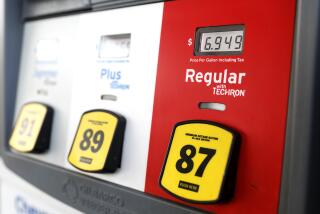Why is California gasoline so expensive?
Gasoline sold in California costs more than in the rest of the U.S. — sometimes dramatically so. That’s because the Golden State’s market is isolated from outside fuel suppliers that might moderate prices. The fuel market here is an economic island, and occasionally circumstances combine to make California’s gasoline even pricier than on the actual island of Hawaii. Here are some factors that affect California’s pump prices:
Special fuel formulas
California’s tough environmental rules mandate that gasoline sold within the state be produced according to strict formulas that reduce pollution. But the gas is more expensive and difficult to produce than dirtier fuel sold elsewhere. Few refineries outside the state are equipped to produce it. What’s more, the state gasoline formula changes twice a year, from a winter recipe to a summer blend designed to retard evaporation during warm-weather months. The summer blend is even more expensive and trickier to make, increasing the chance of refinery mishaps. In addition, refiners try to use up inventories of one type of fuel before the switch to the other type, increasing the risk of price volatility.
Disappearing refineries
The number of refineries in California has plunged during decades of consolidation. Others were weeded out by the expensive investments required to comply with clean-air standards. In addition, major oil companies worked diligently in the 1990s to reduce refinery capacity so that profits would improve, according in internal company documents uncovered during price manipulation investigations more than a decade ago. The probes, however, found no evidence of collusion or price fixing. In 1982, the state was home to 30 gasoline-producing refineries; now there are 11. Chevron Corp. and Tesoro Corp. control more than 50% of the state’s refining capacity.
Few independent retailers
Of the approximately 10,000 service stations in California, less than 15% are independent and not affiliated with a well-known brand. That means less competition than in many other states that have higher proportions of independents. What’s more, in California, there are no independent refiners to supply independent retailers. As a result, the no-name stations have to buy their fuel from big refining companies that already have contracts with their branded stations. When supplies run short, the unbranded stations may have difficulty getting gasoline, which causes their prices to soar higher than those at branded stations.
No interstate pipelines
Interstate pipelines, like those that flow out of Gulf Coast refineries, could carry gasoline quickly and cheaply to California. But no such pipelines exist into the Golden State from other refining regions. Instead, fuel must come by ship or truck. Only when pump prices are soaring inside California is it worth it to pay those transportation costs for the few out-of-state refiners capable of producing California’s gasoline formula. In addition, California refineries also tend to keep inventories tighter than the national average, federal energy statistics show. As a result, prices surge quickly when a disruption occurs from events such as machinery breakdowns, power outages or labor problems.
High taxes
California drivers pay a hefty toll at the pump in federal, state and local taxes and fees. In all, about 60 cents a gallon goes to those costs, which the oil industry trade group American Petroleum Institute pegs as one of the nation’s highest tabs for gasoline taxes and fees. The tax total for California motorists is constantly changing because one of the taxes — the sales tax — is figured as a percentage of the whole. As a result, when there’s an increase in the underlying price of gasoline, the sales tax also increases. The State Board of Equalization tries to offset changes in the sales tax by annually adjusting the state excise tax. That tax last changed on July 1, declining to 30 cents a gallon from 36 cents.
Lots of driving
California has far more licensed drivers — 24.4 million in 2013 — than any other state, according to the most recent data from the Federal Highway Administration. Many drivers and a robust tourism industry means that the amount of driving within California easily tops that in other states, an estimate expressed in “vehicle-miles” measured at official monitoring stations. In April, for instance, motorists cruised through 31.1 billion vehicle-miles on California roads, up 5.2% from April 2014. Texas came in second at 21.9 billion vehicle-miles. Increased vehicle fuel efficiency has caused overall fuel consumption to decline in the state during the last decade. Still, gasoline demand remains high — nearly 15 billion gallons in 2014.
------------
FOR THE RECORD
9:54 a.m.: An earlier version of this article stated that motorists in April drove 31.1 million vehicle-miles on California roads, and that Texas came in second at 21.9 million vehicle-miles. The figures are 31.1 billion vehicle-miles for California and 21.9 billion vehicle-miles for Texas.






